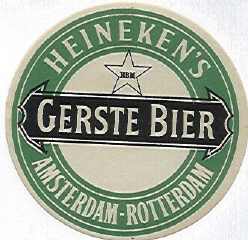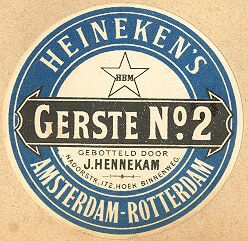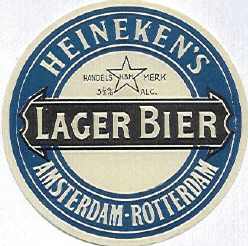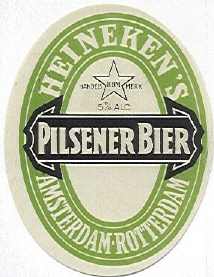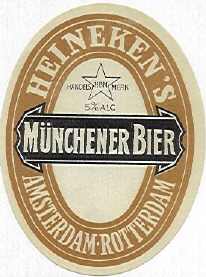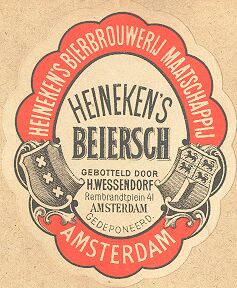| The
Dutch brewing industry |
The ruthless strategy employed by Heineken has left Holland
with just a handful of established independent breweries. Only two breweries
have managed to muster any sort of serious opposition - Bavaria and Grolsch.
Their strategies have been very different; Grolsch has concentrated on quality,
Bavaria on price. Guess which I prefer.
The current number of active breweries is 68 (well, 58 physical breweries).
They break down as follows:
| Brewery |
No. |
Details |
| Heineken |
3 |
Has two breweries under the Heineken name in Den Bosch and Zoeterwoude
plus the Brand brewery, which operates fairly independently. Contrary
to what their labels imply, there is no Heineken brewery in Amsterdam. |
| Bavaria |
2 |
Holland's number two. Concentrates on the cheap and nasty end of
the market. Also owns the La Trappe brewery. It closed the tiny Kroon
brewery soon after buying it. |
| Grolsch |
1 (3) |
Has been temporarily operating three breweries. When the new brewery
in Boeklo (just outside Enschede) is fully up and running, the plants
in Groenlo and Enschede will close. |
| Inbev |
2 |
Dommelsch and Hertog Jan. Its largest Dutch brewery, Oranjeboom
in Breda, closed in 2004. |
| Independents |
5 |
Alfa, Budels, Gulpener, Lindeboom, and Leeuw which is owned by the
Belgian brewery Haacht. |
| Brewpubs |
12 |
Relatively few brewpubs have been started - possibly because of
the small size of most Dutch pubs. |
| Microbreweries |
33 |
Far more common than brewpubs in Holland. |
| Contract brewers |
10 |
A very Benelux phenomenon - companies who contract other breweries
to brew their beers. It isn't as dodgy as it sounds; some of the best
Dutch beers are brewed this way. S.N.A.B.
is a good example of how well it can work. |
|
| Brewers'
Organisations |
Centraal Brouwerij
Kantoor
Herengracht 282,
1016 BX Amsterdam.
Postbus 3462,
1001 AG Amsterdam.
Tel: 020-625 22 51
Fax: 020-622 60 74
E-mail: info@cbk.nl
http://www.cbk.nl/
The big boys' club. |
Klein
Brouwerij Collectief
info@kleinbrouwerijcollectief.nl.
http://www.kleinbrouwerijcollectief.nl/
Founded in 2003, around 40 smaller, new breweries are members. |
Beer Drinkers' Organisation
The Dutch beer consumers organisation (an EBCU member) is:
PINT
Postbus 3757,
1001 AN Amsterdam.
http://www.pint.nl/
PINT (Vereniging Promotie INformatie Traditioneel Bier) was founded 14th
October 1980 as one of the first beer organisations in continenal Europe.
It has around 3,000 members.
|
| Dutch
Beer styles |
The beers brewed in Holland can be roughly classified into four groups:
Pre-1980 breweries mostly stick to lagers. That's
their bread and butter. All have played around with other styles as beer
consumption has fallen and more Belgian ales have been imported. Even Heineken
(with Wieckse Witte) have had a try. But it's clear that they consider top-fermenting
beer as no more than a lucrative niche market. Before 1980, the entire Dutch
beer industry was bottom-fermenting. Of the micros, only St. Christoffel
concentrates on bottom-fermented beers.
The microbreweies and (occasional brewpubs) founded in the last couple of
decades usually top ferment. Their founders were inspired by Belgian
imports and have strived to emulate them. With varying degrees of success,
it must be said. Some have fully taken on board the Belgian philosohphy
and brew individual beers that belong to no specific style. Again, with
varying degrees of success.
Occasionally, a new brewery has drawn influences from British
brewing. Some in the form of a single beer, others in their whole range.
Only the ex-Firkin brewpub in The Hague
has ever done the full monty of cask condtioning.
Rarest of all are old Dutch beer styles. Only
Jopen have made a real commitment to reviving
pre-lager types.
|
Bottom-fermenting
beers
Pils, pils and more pils. The older breweries produce little other than
pils. It can get very dull.
Browse through old Heineken labels and you'll see
that they used to make a full range of lager styles - Vienna, Münchner,
etc. Sadly, those days are long gone. Some of the independent breweries
make a Dortmunder Export, but that's about it for lager styles. Except,
of course, for seasonal Bocks in the Spring and Autumn.
Lager brewing started at the end of the 19th century, when new, specialist
bottom-fermenting breweries were built. Here are a few examples:
| Year |
Brewery |
Location |
| 1864 |
Koninklijke Nederlandsche Beiersche Bierbrouwerij |
Amsterdam |
| 1870 |
Heineken |
Amsterdam |
| 1871 |
Amstel |
Amsterdam |
| 1872 |
Zwarte Ruiter (later Ridder) |
Maastricht |
| 1873 |
Amersfoortsche Beierischbrouwerij |
Amersfoort |
| 1874 |
Heineken |
Rotterdam |
| 1882 |
Zuidhollandsche Bierbrouwerij (ZHB) |
Den Haag |
| 1883 |
Deli |
Amsterdam |
The beer that they initially brewed was a dark Münchener lager. The
first pale "Pilsner bier" didn't appear until around the turn
of the century.
| Style |
alc. |
description |
| Pilsener |
5% |
The standard very pale, vaguely hoppy sort of crap sold everywhere.
Of the examples from established brewers, only Grolsch
Premium Pilsner, Brand Urtyp Pils
and Amstel 1870 are worth drinking.
The micro Christoffel brews
an outsanding unfiltered pils.
Most Dutch beers purporting to be in this style aren't - they're more
like a Helles.
In 2004, Pils accounted for around 93% of beer sales in Holland. |
| Oud Bruin |
2.5 - 3.5% |
A sweet, low-alcohol beer that is totally different
from the Belgian style with the same name. Often sweetened with saccharine.
Not very interesting, but generally less nasty than Dutch pils. |
| Meibock |
6.5% |
A pale bock. Usually far too sweet and without the necessary balancing
bitterness. A seasonal beer sold in the Spring. Almost all are crap.
The style was unknown in Holland before 1990. |
| Bock |
6.5% |
Dark bock. Between ruby red and near black in colour. A sesonal
beer sold from October to December. These beers have become increasingly
sweet in the last decade, as everyone has tried to emulate the success
of the ludicrously sugary Grolsch Herfstbok.
Amstel Bok remains surprisingly
(I have very low expectations of big breweries) good. |
| Strong pale lagers |
7-11% |
Not really true bocks. Amstel
Gold, Grolsch Het Kanon and Bavaria
8.6 are examples. Usually pretty crap. |
| Münchener |
6% |
Only one Dutch brewery makes a real Münchener dark lager: Christoffel.
Their Robertus is one of the best beers of this type brewed outside
Bavaria. Many bottom-fermenting breweries made this style of lager
until the 1960's. |
| Dortmunder |
6-7% |
Also known as "Export". Golden lagers that are stronger,
darker and maltier than standard pils. Gulpener
Dort is probably the best known example. |
|
Belgian-style
top-fermenting beers
In 1980 Dutch breweries were 100% bottom-fermenting, except for La Trappe.
The new microbreweries which began to appear in the mid-1980's found their
inspiration south of the border. They mostly tried to emulate abbey-style
ales - Dubbel and Tripel.
| Style |
alc. |
description |
| Witbier |
5% |
Very pale beers made from around 40% unmalted wheat and flavoured
with coriander and curacao peel. Most Dutch versions are inappropriately
sweet and have purged any trace of sourness. A style that is brewed
by most Dutch breweries, old and new. |
| Amber |
5% |
The Belgian version of an English pale ale. Malty and (in principle,
at least) with a good degree of hop bitterness. The best Dutch example,
Grolsch Amber, is no longer with us. A pity the same isn't true of
Vos and Moreeke. |
| Blond |
6-7% |
Disgusting pale, sweet beers which try to imitate the revolting
Leffe Blond. All beers in this style are crap. |
| Dubbel |
6 - 7% |
Sweetish, dark ales with a degree of malt bitterness.
One of the styles Dutch micros find it easier to get their heads around.
|
| Tripel |
8-9% |
Pale, powerful ales, where the underlying sweetness should be balanced
with massive hopping. Are sometimes spiced (with coriander, for example). |
| Strong ale (light) |
8-11% |
Anything strong and pale that doesn't have the word "tripel"
anywhere on the label. La
Trappe Quadrupel is an example - sort of like a Barley Wine. |
| Strong ale (dark) |
8-11% |
As above, but dark. |
| Saison |
6-7% |
Pale, spicy dry ales. |
| Strong Golden |
8-9% |
A crap name, I know, but the guys at Moortgat have a copyright on
"Duvel". The Dutch are even less successful than rival Belgian
breweries at capturing the particular magic. Oh yes, almost forgot
- remarkably pale, fresh, dry, devilishly drinkable and hoppy. (Well,
that's what Duvel is like.) |
|
British-style
top-fermenting beers
Before bottom-fermenting hit the Netherlands in the 1860's, many Dutch breweries
tried their hand at British styles. In some cases these hung on well into
the 20th century.
New Dutch breweries have been keener on Belgian stuff than the wonderful
top-fermenting tradition (I had promised myself never to use that word again,
unless my plums were in a nutcracker) of the British Isles .
| Style |
alc. |
description |
| Pale Ale/Bitter |
4-5% |
Amber, malty ales with a fair dash of bitterness. |
| Mild |
3 - 4% |
A sweetish, low-alcohol ale. The Fiddler
brewpub usually has one as a seasonal special in May. |
| IPA |
5-6% |
Pale, intensely hoppy ales. Brewed by a couple of micros, most notably
SNAB. |
| Porter |
5-6% |
The junior member of the stout family, black and roasty with perhaps
a touch of malty sweetness. Brewed by a couple of the newcomers. |
| Stout |
5-8% |
Once common enough to appear in brewers' price-fixing
agreements. Heienken brewed a bottom-fermenting stout into the
1990's. The Fiddler brewpub does
a very tasty cask-conditioned example. SNAB make a meaty Imperial
Stout. |
|
Old
Dutch styles
Mostly brewed by a single contract brewer, Jopen.
| Style |
alc. |
description |
| Jopenbier |
7% |
Amber, hoppy beer. |
| Koyt |
8% |
Dark ale. Multigrain gruit beer. |
| Mestreechs Aajt |
3.5% |
A sour brown beer, made by mixing barrel-aged beer with young beer.
Related to Flemish Brown and Red ales. Much more interesting than
its modest strength implies. Brewed only by Gulpener. |
|
| Dutch Beer styles 1880 - 1900 |
There's
a fascinating document hidden away in an appendix of "Korte Geschiedenis
der Heineken's Bierbouwerij Maatscappij N.V. 1873 - 1948". It's the
draft of an 1893 price-fixing agreement between Amsterdam brewers.
What's so interesting about it? Well, it gives us a glimpse of the beer
styles then being brewed in Holland.
| beer type |
max. º Balling |
minimum price per litre |
| Hollandsch Bier |
9º |
7 cents |
| Nieuw Hollandsch Bier |
9º |
7 cents |
| Lager Bier |
11º |
9 cents |
| Extra Lager Bier |
11º |
9 cents |
| Pilsener |
15º |
9 cents |
| Münchener |
15º |
9 cents |
| Dortmunder |
15º |
14 cents |
| Brown Stout |
16º |
16 cents |
| Extra Stout |
19º |
20 cents |
Source:
"Korte Geschiedenis der Heineken's Bierbouwerij Maatschappij
N.V. 1873 - 1948" (p.421, 422) |
| Heineken products in 1864 |
| beer type |
| Versche bier |
| Hooibouwbier |
| Ale |
| Porter |
| Faro |
| Oud Bruin |
| Beyersch |
Source:
"Korte Geschiedenis der Heineken's Bierbouwerij Maatschappij
N.V. 1873 - 1948" (p.42) |
| Heineken wholesale
prices (per litre) |
| beer type |
1886 |
1904-1914 |
| Gerstebier |
10 cents |
8 cents |
| Lager |
- |
8 cents |
| Rotterdamsche Gerste |
- |
11 cents |
| Münchener |
14 cents |
14 cents |
| Export |
- |
14 cents |
| Beiersch (donker) |
13 cents |
13 cents |
| Pilsner (licht) |
13 cents |
13 cents |
| Bock |
- |
15 cents |
Source:
1886 - "Korte Geschiedenis der Heineken's Bierbouwerij
Maatschappij N.V. 1873 - 1948" (p.117)
1904-1914 - "Korte Geschiedenis der Heineken's Bierbouwerij
Maatschappij N.V. 1873 - 1948" (p.218) |
(Labels courtesy of Felix Groenewoud)
Gerste No. 1 and the even lower quality Gerste No. 2 formed a major part
of Heinken's output in the late 1880's. Both were bottom-fermented beers,
using the Heineken D-yeast. Stronger beers and those intended for export
used the A-yeast - still used by Heineken today. They were isolated in Heineken's
Rotterdam brewery in 1885. The A-strain was sold on to breweries in Belgium,
Denmark, France and Germany. Apparently, the Heineken yeast was used by
many Munich breweries because they were unable to propagate single-strain
cultures as effectively.
(Source: "Korte Geschiedenis der Heineken's Bierbouwerij
Maatschappij N.V. 1873 - 1948" (p.110-113))
In 1875 Heineken exported beer slightly differently during the winter months.
Their Lagerbier (or Bière de Conserve as it was called in French-speaking
countries) was delivered in two forms: with or without yeast. The reason
for this was that, in cold weather, beer could freeze in transit. Evidently
this destroyed the flavour. The presence of yeast in the barrel helped to
prevent the beer freezing. The beer with yeast was intended for immediate
consumption, whereas that without could be kept longer. Other brewers (according
to Heineken) produced a lighter beer in the Winter that was sold 3 or 3.5
weeks old - very young. I wonder how long your average Heineken today spends
between mash and stomach?
(Source: "Korte Geschiedenis der Heineken's Bierbouwerij
Maatschappij N.V. 1873 - 1948" (p.73))
|
More breweries, more beer styles
This excellent site of old
Dutch beer labels gives a good impression of the range of styles once
brewed in Holland.
|
